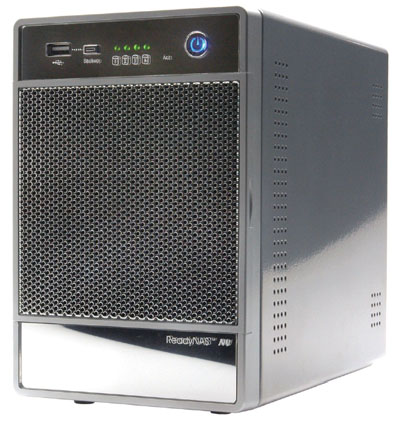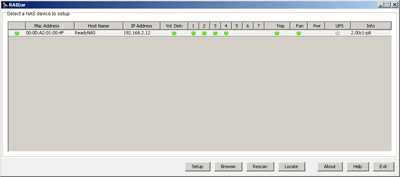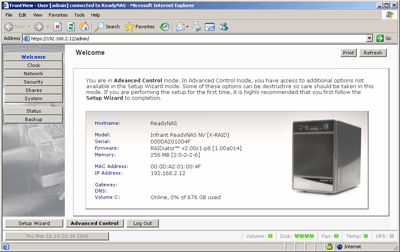
Original Link: https://www.anandtech.com/show/1973
Infrant Technologies’ ReadyNAS NV: Enterprise Features, Desktop Footprint
by Purav Sanghani on March 17, 2006 11:42 AM EST- Posted in
- Storage
Introduction
We have been looking at external storage devices that can connect directly to PCs or file servers by way of USB and FireWire interfaces. This has wowed many desktop users who need very little when it comes to configurability. However, those external hard drive storage devices have their limitations and are not ideal solutions for those who want to manage shares and provide security in the home or small business. The part that most concerns us is that those products also do not offer any type of data protection or redundancy to reduce the risk of data loss due to disk failure.
Infrant Technologies is one of many companies who has taken this into account. They have combined the portability and simplicity of a desktop external storage device and the data redundancy and user security features of an enterprise network attached storage device into an extremely small form factor package called the ReadyNAS.
A few months back, Infrant sent us their 1TB ReadyNAS X6, which featured a custom operating system, RAIDiator, and their patented X-RAID technology, which allowed them to bring the redundancy features of enterprise class servers to the desktop. Since then, they have also released an updated version of the ReadyNAS 600 and X6 models, named the ReadyNAS NV. Take a look at the differences between each model at Infrant’s website.
Beauty on the Outside
Infrant has put their desktop ReadyNAS model through three generations of changes with the original being the ReadyNAS 600. The most noticeable difference of the NV model from the 600 and X6 is the smaller form factor. The new ReadyNAS NV model is now half the size of the original ReadyNAS, which gives it a desk space-saving footprint. The look has also been improved with reflective mirror panels at the head and foot of the front bezel and a plastic door, which features a holey grating for airflow.
The head of the front bezel features, from left to right, a USB 2.0 port to which to connect digital cameras or personal media devices, an instant backup button (which backs up data from the NV’s “backup” share to a separate USB device), 4 HDD activity LEDs with icons to show their designated drives, an activity light labeled “ACT”, and finally, the power button, which is about a half an inch in diameter and features a blue LED lit power icon.
The ReadyNAS NV model features hot swappable drive bays that can be found by swinging the grated door out from the right to the left. We now see four vertically mounted hot swap bays with the drive trays in place. To remove the drive tray, we push forward on the dark gray plastic at the bottom of the chassis to snap open the light gray handle, which allows us to pull the drive tray out of the bay from the front to install the hard disk drives. Since these are hot swap bays, there is no wiring needed like there was with the X6 and 600 series.
The back of the ReadyNAS NV features a very simple set of connections. The power connector is located at the bottom left, which is a standard 3-prong computer plug making it simple to swap out the cable for a new one if something were to happen to the original. At the top right of the backside of the NV, there are 2 USB 2.0 ports and a 10/100/1000Mbps Ethernet port aligned vertical in that order.
Beauty on the Inside
The ReadyNAS X6 and 600 series devices in version A used a motherboard that featured upgradeable DDR SODIMM RAM and a CompactFlash card, which held the RAIDiator operating system and the FACTORY reset backup information. The NV series still has the upgradeable RAM starting at 256MB, but features 64MB of onboard flash to accommodate the OS.
The guts of the ReadyNAS NV include the IT3107 network storage processor (NSP), which is a 32-bit RISC processor running at 280MHz. It features the X-RAID technology, which allows us to increase the size of RAID volumes on-the-fly without the need to reformat or rebuild any arrays as if we were using enterprise class hardware. The IT3107 allows up to 4 SATA channels, which can be configured in RAID 0/1 as well as RAID 0/1/5 and X-RAID. Before receiving the newer NV model, which Infrant sent as a bare unit without hard disk drives, they informed us that we could use our RAID set from the X6 in the NV. This did not surprise us, since the platforms are almost completely identical, but it did give us goose bumps to be assured that we wouldn’t have to go through the RAID rebuild process.
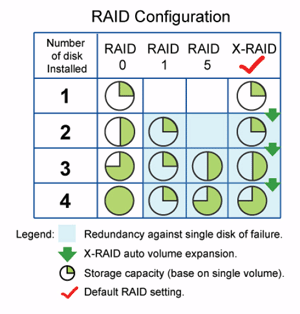
Speaking of media, the ReadyNAS devices all carry UPnP support to interface with set top media boxes to stream audio, video, and pictures from the NAS to a TV anywhere in the house. Additionally, the ReadyNAS devices have printer network-ability and can also download images automatically off of a digital camera or download audio from a personal audio device without any other human interaction besides plugging the devices into the USB ports.

RAIDar – Device detection software
Infrant has designed their own proprietary operating system, which allows complete control over the configuration of the ReadyNAS devices. To detect the NAS after it has been fully booted, we start the included RAIDar software to find any ReadyNAS devices on the network. Note that the initial setting for the ReadyNAS devices out of the box is in DHCP mode, so we set our PC accordingly. The utility will display all of the devices that it is able to detect in the window as shown in the screenshot below.
This screen shows important information of the device such as MAC/IP addresses, Host name, volume information of the RAID array as well as information about the individual disks/USB drives installed (mouse over), drive and unit temperature status, fan status and UPS information. The last column shows the version of the OS installed on the device. We can then choose the specific device (in our case, there is one directly connected to our test machine), and choose either to set up the device, browse the shares, or rescan the network for ReadyNAS devices. There is also a “Help” option, which brings up an HTML page that explains briefly the various features of the RAIDar utility.
RAIDiator OS
To begin configuring the ReadyNAS device, we can either use the RAIDar software to find and log into the device’s user interface or we can open a web browser and enter the IP address of the device if it is known to us. For the first run, we ran the RAIDar utility, since the device was set to DHCP mode. Note that we used an Intel Pro/1000 MT desktop card, which supports gigabit Ethernet and Jumbo frames to test the ReadyNAS X6 and NV.
We are prompted to enter a login and password to get into the user interface. The credentials are set at the factory and can be cleared with a factory reset, but it can also be reconfigured. Once we enter our login information, we are presented with the initial setup screen in the Setup Wizard mode. This wizard basically walks us through each page step by step to configure and customize various aspects of the device, like its identity on the network, user accounts, designated shares, performance options, and various other features.
The alternate method of configuring the ReadyNAS device is to click over to the Advanced Control mode, which gives us more control in navigating the interface. In this mode, we are shown the main sections as buttons on the left side of the window. Once we click on a main section, the main frame is populated with that section’s content and all of the subsections divided by tabbed pages. This mode also shows us feature options and configuration options that we would not see in the Wizard mode.
The Test
Network attached storage devices carry a lot more burden as opposed to external hard disk drives due to the nature of their uses in multi-user environments. We have included our usual File System Performance benchmarks, but have also added some IO tests to simulate multi-user scenarios.
| Infrant Technologies ReadyNAS NV Test Bed | |
| Processor: | AMD Athlon 64 3500+ (2.2GHz, 512KB L2 Cache, Socket 939) |
| Motherboard/Chipset Drivers: | Giga-Byte GA-K8NXP-SLI nForce4 (v6.66) |
| Hard Disk Drives: | Western Digital WD1600JS |
| RAM: | 1GB Corsair XMS4400 DDR2 (2x512MB) |
| Video Card: | ATI Radeon X300, Fanless |
| Network Interface Card: | Intel Pro/1000 MT 10/100/1000Mbit w/Jumbo Frames = 9014bytes |
The ReadyNAS devices are directly connected to our test system’s Intel Pro/1000 MT interface during our benchmarking process using the CAT5 cable provided by Infrant Technologies. The Seagate RAID 5 array is built using the same four Seagate drives that come with the 1TB ReadyNAS NV.
Our test methods are as follows:
| AnandTech NAS Device Benchmarks | |
| File System Performance | File Copy - We copy a single 300MB file and three hundred 1MB files to and from the device and measure the time of each run |
| SiSoft Sandra | File System - Measures various read/write operations Network/LAN Bandwidth - Measures achievable network bandwidth |
| IOZone | Measures file transfer rates for various file size and transfer size combinations and reports write and read results |
| Iometer - 2004-07-30 | Tests data throughput |
Real World Tests – File System Performance
For our Real World File System Performance tests, we have taken the original tests and tailored them for external drives. More specifically, instead of just measuring the time that it takes to copy, zip, and unzip within the same drive, we measure the time that it takes to perform these tasks from a SATA drive to the external device.
File Copy Operations
| File Copy - One 300MB File, seconds, lower is better | |||
| To NAS | From NAS | ||
| ReadyNAS NV | 13.621 | 8.636 | |
| ReadyNAS X6 | 21.422 | 10.042 | |
| Seagate 250GB 7200.9 RAID 5 | 4.750 | 5.672 | |
| File Copy - Three Hundred 1MB Files, seconds, lower is better | |||
| To NAS | From NAS | ||
| ReadyNAS NV | 19.102 | 13.562 | |
| ReadyNAS X6 | 36.844 | 14.573 | |
| Seagate 250GB 7200.9 RAID 5 | 7.465 | 6.709 | |
The results show a substantial performance increase on the NV over the X6 ReadyNAS device in the File Copy tests to and from the devices.
SiSoft Sandra
SiSoft Sandra contains various benchmarks including file system and network bandwidth tests.
| SiSoft Sandra Results | ||||
| ReadyNAS NV | ReadyNAS X6 | Seagate 250GB 7200.9 RAID 5 | ||
| File System Benchmarks | ||||
| Drive Index (MB/sec) | 29.1 | 24 | 60 | |
| Buffered Read (MB/sec) | 47 | 46 | 226 | |
| Sequential Read (MB/sec) | 33 | 29 | 66 | |
| Random Read (MB/sec) | 23 | 21 | 55 | |
| Buffered Write (MB/sec) | 32 | 25 | 106 | |
| Sequential Write (MB/sec) | 21 | 17 | 64 | |
| Random Write (MB/sec) | 21 | 17 | 42 | |
| Average Access Time (ms) | 13 | 9 | 3 | |
| Network Benchmark | ||||
| LAN Bandwidth (MB/sec) | 24.3 | 22.48 | NA | |
Iozone Results
Iozone is a command-line benchmark, which is very extensive in testing various combinations of file sizes and transfer sizes to measure average transfer rates. We used the following command to run the benchmark:
iozone -Rab [results file name] -i 0 -i 1 -g 1G -+u -f [path to directory on NAS device under test] -zThe output CSV file produced results for re/write and re/read operations as well as the amount of CPU time used during the specified operations. The most important results, however, are the transfer rates for files of the following sizes: 64KB, 4096KB, 512MB, and 1GB. We carefully chose these file sizes to report because we believed these to be the most common sizes of files used on a daily basis by the typical home/small office client.
Write Benchmarks
Below are the graphed results for the write portion of the Iozone benchmark. To get a better look at how the two ReadyNAS devices compare, we created two separate graphs for each file size tested: one without the Seagate RAID 5 array, and the other, the mouse over image that includes the Seagate results. The comparison between the NAS devices is clearer without the Seagate data on the chart. Alternatively, we have posted the PDFs (graphs) and Excel files (raw data) of the results to provide some extra numbers to look at here.
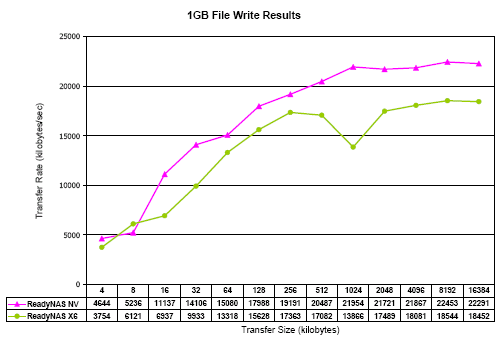
Hold your mouse over to compare to Seagate's 250GB 7200.8 x 4 in RAID 5.
We see an improvement in performance with the ReadyNAS NV while transferring 512MB and 1GB files, which is great for media servers that serve movies. However, according to our results, transferring audio files will reflect the performance that we ended up with on the last generation ReadyNAS X6.
Read Benchmark
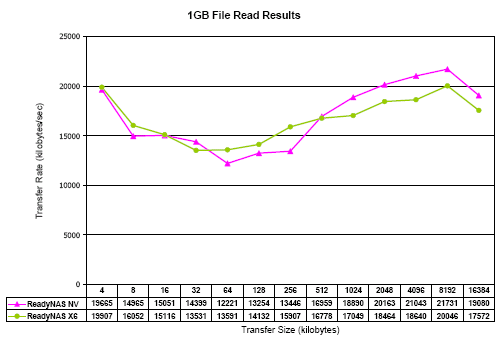
Hold your mouse over to compare to Seagate's 250GB 7200.8 x 4 in RAID 5.
IOMeter Results
| IOMeter (2004-07-30) Results | ||||
| ReadyNAS NV | ReadyNAS X6 | Seagate 250GB 7200.9 RAID 5 | ||
| File System Benchmarks | ||||
| Total IO/sec | 28 | 24 | 60 | |
| Total MB/sec | 47 | 46 | 226 | |
| Sequential Read (MB/sec) | 33 | 29 | 66 | |
| Random Read (MB/sec) | 23 | 21 | 55 | |
| Buffered Write (MB/sec) | 32 | 25 | 106 | |
| Sequential Write (MB/sec) | 21 | 17 | 64 | |
| Random Write (MB/sec) | 21 | 17 | 42 | |
| Average Access Time (ms) | 13 | 9 | 3 | |
| Network Benchmark | ||||
| LAN Bandwidth (MB/sec) | 24.36 | 22.48 | NA | |
The results above from IOMeter’s 2004-07-30 build show the NV’s improvement in performance over the last generation ReadyNAS device. Though the performance has increased in all areas all around, the greatest improvement is seen in the Buffered Write numbers at an average increase of 7MB/sec.
Final Thoughts
Since we did not have any set top media players, we could not test the functionality of the UPnP capability implemented into the ReadyNAS devices. However, from all of the other capabilities that we were able to see, both the ReadyNAS NV and the older X6 have an extremely high degree of configurability compared to some of the other desktop/small office network attached storage devices out there that we have come across.
At first glance, we were extremely impressed with the easier-to-use hot swap drive bay feature that Infrant implemented with this model, especially because the device contained so many enterprise-like features such as RAID hot swap where if a drive in an array fails, it can be easily replaced without the need to rebuild the array. Also, for those who have the X6 or even the 600 series ReadyNAS devices, if you are looking to upgrade to the NV, Infrant makes it simple by allowing you to move your current drive set to the new device without the need to rebuild the array because the same software is used on all devices.
Our benchmarks showed great improvement of the ReadyNAS NV over the X6 model, especially in the Iozone “write” tests. Transferring a 512MB or 1GB file showed increased performance over the X6, which was expected from what Infrant had told us. Though the read tests did not prove much of anything, it was clear from all of the synthetic tests that Infrant put a lot of effort into making the NV model easier to use in the desktop environment as well as perform better in all types of environments. SiSoft Sandra and Iometer as well as our own homebrew File Copy tests showed improvement in all areas, which is reason enough to go with the ReadyNAS NV over the X6 model.
The ReadyNAS NV comes in 3 flavors including a core unit with no drives at a retail price of $649, a 1TB (terabyte) version that retails for $1199, a 1.6TB version at $1699, and a 2TB version at $2299. The 2TB version includes four Seagate 7200.9 500GB hard drives and we wouldn’t be surprised to see the ReadyNAS supporting higher capacity drives as they come out. We can’t wait to see 3-4TBs sitting on our desktops soon!

